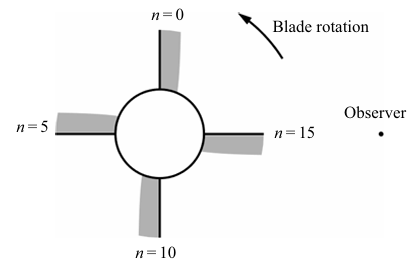I have a query on where propeller blade loading points. On this paper I found this picture:
In that paper, they say that, if we define a vector $\vec{R}$ from source (blade section) to observer, and a unit vector $\vec{n}$ aligned with the local force exerted by the blade on the fluid, the dot product $\vec{R} \cdot \vec{n}$ will be maximum when "the net loading exerted by the blade on the air points towards the observer". Specifically, they say that $\vec{R} \cdot \vec{n}$ has a "maximum magnitude when the blade is moving towards the observer". This occurs about at $n=10$ in the above picture.
What I'm wondering is: how is it possible that at $n=10$ (or a bit later than that) the loading is pointing in the direction of the observer? I mean, at $n=10$ the blade is showing its pressure surface to the observer and we know that the loading exerted by the blade on the fluid points away from the suction surface, instead, which is on the other side.
Thank you for your help.

